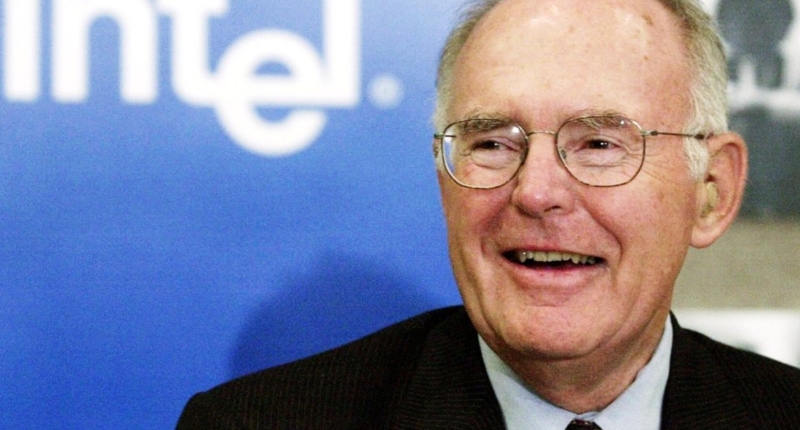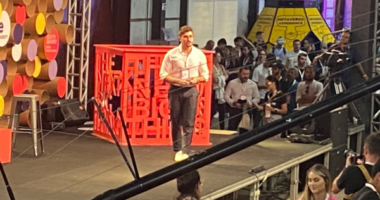Silicon Valley has lost one of its giants with the passing of Intel co-founder Gordon Moore at the age of 92. The co-founder of Intel, who contributed to creating a multi-billion dollar semiconductor industry, died at his home in Woodside, California. Moore was renowned for Moore’s Law, his prediction that the number of transistors on a microchip would double roughly every two years, which became a guiding principle for the industry. Moore’s relentless innovation and business acumen enabled Intel to dominate the chip industry, and his net worth peaked at $26bn by 2000. Although his fortune declined with Intel’s share price, he and his wife, Betty, donated more than $5.1bn through their foundation, focusing on environmental conservation, science, and Bay Area causes.
Gordon Moore, Co-founder of Intel, Dies at 94
Gordon Earle Moore, the renowned Silicon Valley entrepreneur, who co-founded Intel and Fairchild Semiconductor, passed away at the age of 94. The legendary pioneer, who was famously known for his law about the inevitable technological advancements in chip technology, died on Friday.
Moore’s exceptional leadership skills led Intel to phenomenal growth, which inspired numerous tech entrepreneurs worldwide. His success in the tech industry made him one of the wealthiest individuals globally. Despite his enormous wealth, Moore was a humble individual who was content with fishing in the wilderness. He was renowned for donating most of his fortune to environmental and other philanthropic causes.
Moore was born on January 3, 1929, in San Francisco and was raised in Pescadero and Redwood City. His father was a patrolling officer at the San Mateo County Sheriff’s Office, and his mother was a homemaker. During his teenage years, he developed a keen interest in science and began experimenting with his neighbor’s chemistry set. He enjoyed triggering explosions by hammering drops of nitroglycerin on an anvil, which ultimately led to permanent hearing damage.
Moore earned his doctorate in chemistry and physics from the California Institute of Technology in 1954. However, he lacked business training and was unaware of how to run a company or start one.
Moore wrote in a 1994 article about his life for Caltech’s Engineering & Science quarterly, “There is such a thing as a natural-born entrepreneur, for whom the entrepreneurial urge drives everything and who can make a business out of almost anything. But the accidental entrepreneur like me has to fall into the opportunity or be pushed into it.”
His first business venture was unsuccessful when he applied for a management position at Dow Chemical, but a Dow psychologist who interviewed him concluded that he was only suitable for technical work and not management. Moore eventually landed a job at Johns Hopkins University’s Applied Physics Laboratory. He later longed to return to California and was hesitant to get involved in nuclear blast studies at the Lawrence Livermore Laboratory, so he joined Shockley’s Mountain View startup in 1956.
Gordon Moore’s contributions to the tech industry were immeasurable, and his passing is a significant loss. His name will forever be etched in history, and his legacy will continue to inspire generations to come.
Gordon Moore, Co-founder of Intel and Fairchild Semiconductor
Gordon Moore was a renowned Silicon Valley pioneer who co-founded Intel and Fairchild Semiconductor. He is famously known for formulating Moore’s Law, which predicted the inevitable advancements to come from chip technology. Moore passed away at the age of 94.
After working at Johns Hopkins University’s Applied Physics Laboratory, Moore joined Shockley’s Mountain View startup in 1956, which was developing inexpensive silicon transistors. But morale at the company quickly deteriorated due to Shockley’s abrasive idiosyncrasies, and Moore and seven co-workers quit to form Fairchild Semiconductor in 1957. The business hit a technological home run when one of the founders, Robert Noyce, co-invented the microchip.
In the late 1960s, Fairchild had 30,000 employees and was racking up $150 million in annual sales. Moore and Noyce left in 1968 and founded NM Electronics, which was later renamed Intel.
During his involvement with the company, Intel became a global tech powerhouse, making memory chips and microprocessors that serve as the brains of most personal computers. Its stock market value flirted with a half trillion dollars in 2000. While that has dropped to about 200 billion, Intel is the world’s biggest chip maker and the fourth biggest revenue generator in Silicon Valley.
But Moore’s fame is mostly attributable to Moore’s Law, which he initially published in a 1965 Electronics Magazine article. He predicted that the number of tiny transistors squeezed onto chips would roughly double every year. In 1975, he changed that to every two years, a revision that has generally proven prophetic.
“We didn’t have any idea of the magnitude of the opportunity we were dealing with,” Moore recalled in his 1994 article. “We were still a bunch of guys in a laboratory, somewhat amazed that people actually wanted to buy our products.”
Moore’s entrepreneurial achievements and contributions to the tech industry will always be remembered. He was a down-home, self-effacing person who was praised for donating much of his wealth to environmental and other philanthropic causes.
Gordon Moore, Co-founder of Intel and Fairchild Semiconductor
Gordon Moore was a highly respected Silicon Valley figure and co-founder of Intel and Fairchild Semiconductor. He is renowned for formulating Moore’s Law, a prediction of the advancements that would come from chip technology. Moore passed away at the age of 94.
Moore’s Law, named after him by his friend and Caltech professor Carver Mead, predicted that the number of tiny transistors squeezed onto chips would roughly double every year. Initially published in a 1965 Electronics Magazine article, he later updated it to every two years in 1975. It is widely regarded as one of the most important laws in the tech industry.
While Moore was hailed for his exceptional talent in both businesses and science, he remained modest and self-effacing throughout his life. He was known for his self-deprecating humor and down-to-earth sagacity. Despite the success he enjoyed, Moore acknowledged that he was “lucky enough to be at the beginning of a major industry at a time when what I knew was useful.”
In addition to his work in the tech industry, Moore was passionate about environmental conservation and science. He and his wife, Betty, established the Gordon and Betty Moore Foundation in 2000 to finance these causes. Using $5 billion worth of Intel stock, the foundation has given over $5.1 billion to beneficiaries ranging from the Tech Museum of Innovation to the Peninsula Open Space Trust to the Alameda County Medical Center.
Moore was deeply concerned about the natural world and the loss of once-pristine places due to civilization’s relentless intrusion. He was also dismayed by the loss of the Bay Area’s once-vast agricultural areas.
Moore’s entrepreneurial achievements and contributions to the tech industry will always be remembered. His legacy lives on through Moore’s Law, which has become a testament to the spirt of innovation and the boundless possibilities of technology.
Gordon Moore’s Love for Nature and Technology
Gordon Moore, co-founder of Intel and a legendary Silicon Valley figure, passed away at the age of 94. Moore was an example of a natural-born entrepreneur who contributed immensely to the development of technology. Despite being one of the richest men on the planet, he remained a humble person who dedicated much of his wealth to philanthropy.
Moore was a man of many talents. He earned a doctorate in chemistry and physics and was an accomplished businessman. He co-founded Fairchild Semiconductor, which was later acquired by Intel, where he became CEO and Chairman. Moore’s formula, known as Moore’s Law, was published in 1965 and predicted that the number of transistors on a microchip would double every year. This formula has since become an iconic reference in the technology industry.
Moore was also an avid outdoorsman who loved fishing and enjoyed traveling to remote parts of the world where he could escape the hustle and bustle of modern society. He was particularly concerned about the loss of wildlife habitats due to civilization’s constant intrusion. Despite his love for nature, Moore was still fascinated by technology and its ability to transform society.
Moore’s legacy will be remembered not only for his contribution to the development of technology but also for his dedication to philanthropy and environmental conservation. His $5 billion worth of Intel stock went to the Gordon and Betty Moore Foundation to finance environmental conservation, science, and Bay Area causes.
Moore’s passing marks the end of an era, but his contributions to the technology industry will be celebrated for generations to come.
Don’t miss interesting posts on Famousbio









